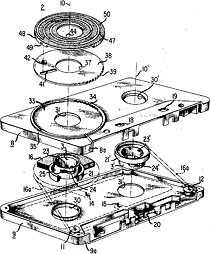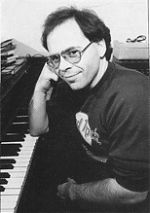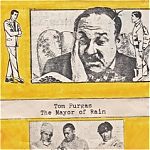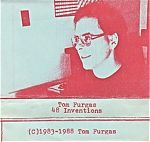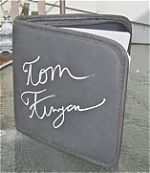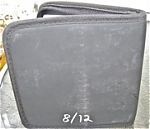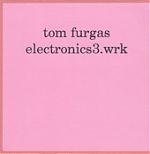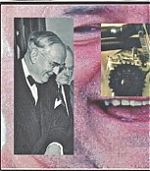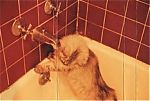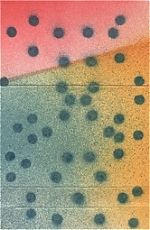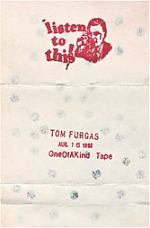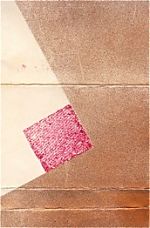Tom Furgas
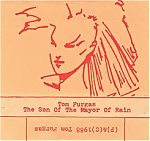
“The Son Of The Mayor Of Rain” from 1988. Like many of his releases, filled to the brim with new ideas and angles.
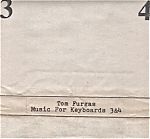
Tom has a love for modern classical piano music and that esthetic sometimes informs his own music and even the minimal approach to the cover on this keyboard tape from 1987.
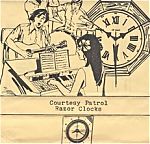
Essentially a “bedroom rock” project, Tom provided most of the music ( with some occasional help from others) and Bill Lehman did the lyrics and vocals in Courtesy Patrol. They had at least a couple of tapes, this one from 1986.
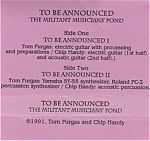
Tom has collaborated with many other home recording artists. Ken Clinger has often been an artistic foil for him. On the 1991 tape above he works his way through some free improvisations pieces with guitarist Chip Handy as the project, The Militant Musicians Pond.
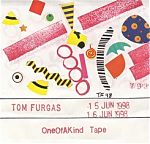
Not only does Tom send you the only copy of the work but he also hand draws,paints, or glues images onto the cover. This is total Art with a capital A and in my humble opinion is what is missing from much of todays “underground” or independent scene. Tom Furgas’ work is never “product” but unique art stylings.
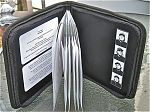
Above and below, some pictures of Tom Furgas limited edition 12 CD set produced in 2003. This massive work featured tons of Tom solo pieces and also contributions from Dino DiMuro, Mark Hanley, Bill Lehman, Don Campau, Zan Hoffman, John Oswald, Mark Chuey and Ken Clinger.
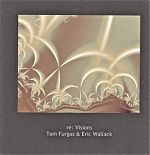
From 2006 a collab with Ohio’s Eric Wallack. Tom uses the Roland Groovebox and synth. Eric employs a mac G4 and also Chapman Stick and acoustic bass.
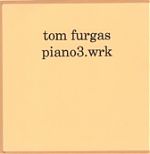
Tom’s design vision sometimes runs to the austere somewhat like Ken Clinger’s. Over the last few years he has produced a sizable quantity of work for piano, electronics, harpsichord and more. You can see how he goes very minimal on these covers.

Relay Music was a project began in the cassette days using digital delay and synth to create sound that unfolds slowly. He continued this project into the CD age in 2000 with the release of this CD
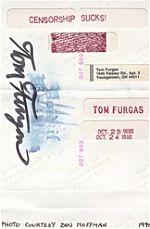
A couple of OneOfAKind tape covers. Tom uses a picture sent from Zan Hoffman and then details the inner cover and signs it. From 1990.
Tom Furgas from Youngstown, Ohio was the first stranger I ever traded tapes with. He sent me his “Mayor Of Rain “ tape in 1984, I believe. Right off the bat I was pumped up about this tape trading network, this chance to connect with like minded creators outside of my normal life. Little did I know that this would become my “normal” life soon enough. His music was unexpected and interesting and he even had constructive criticisms for my own tape which I appreciated. Always honest and open, consumed by the creative urge and lover of many types of music, Tom and I lost touch for a while in the late 90s but then reconnected when we started trading music from our collections, and, of course, our own new creations. We even collaborated on an album, “Marching On”. I’ve never met Tom in person and yet I consider him a very good friend.
What are some of your earliest memories of hearing music at home?Was it important to you then…or was there another trigger later, perhaps The Beatles or something?
I think my real love of music began in kindergarten, when I was 5 years old. The teacher (dear Mrs. Loag) would play the piano while we kids were seated on the floor, singing nursery rhymes and folk songs. Also, when I was 5 I wanted, and got, a record player for Christmas that year, along with tons of records. I was totally hooked. The Beatles came later (1963 or so, when I was in third grade). Saw them on Ed Sullivan on TV, of course, as we all did. I’ve loved their music ever since.
Did you take piano lessons at an early age?
Yes, I told my parents I wanted to play the piano, so they bought a massive old upright piano and took me to lessons with a Mrs. Schwartz. She and her husband were very well-to-do; my lessons were on a grand piano! I also had a few lessons with her daughter Lucille, mostly playing duets in order to learn ensemble playing. These lessons continued for six or seven years. Then I took lessons with a high school friend, Tom Sovik, and had a series of other teachers after him, including Roman Rudnytsky at the Dana School in the early 1970’s.
When/ how did you hear about the tape trading/home recording scene?
I had been doing primitive home taping since I was 14 or so, with a portable cassette recorder and any sound-producing thing I could lay my hands on (acoustic guitars, electric organ, zither, harmonica, percussion of all kinds, found objects, etc.). But I really started doing more serious work in 1980 when I got my first synthesizer (an ARP Solus). I wanted to share my music with other musicians but didn’t know how to get ahold of anyone, so I wrote to Keyboard magazine asking for musical pen pals. They published my letter and I heard from a really cool guy in Sweden, Lennart Ostman, but the really important contact was with C.W. Vrtacek in Milford, Connecticut. He introduced me to OP magazine, where I found the very active and fecund home-taping network.
Who were some of your early trading partners?
Aside from Lennart and Vrtacek there was Mike Roden, a really fun synthesizer player and comic-book artist. Through OP I found many of my still-current trading friends, Zan Hoffman, Dino DiMuro, Ken Clinger, Mark Kissinger, Mark Hanley, and, of course, YOU, Don. Many others, most of whom I have lost touch with since. The trading scene was most intense for me between 1985-1996 or so. By 1996 the effort and cost became too much for me and I began to trim back my recording and trading activities.
You were the first stranger I ever traded tapes with after I saw your “will trade” comment in Option magazine. What prompted you to want to do this…as opposed to trying to sell you music?
Well, I never thought of my stuff as being all that commercially viable. It wasn’t like anything that you could find in the record stores; Madonna, ZZ Top, what have you. I did try selling, and did sell a few here and there ($3 or $5; the three-dollar tapes were the experimental stuff like “Quantum Geometry Networks”, the five-dollar tapes were the more “accessible” ones) but I always preferred trading, in order to hear what other home-tapers were up to. And most of what I heard was creative, fun, fresh, original, and vital. There was no commercial motive, no profit incentive, behind it, just a love of pure music-making. That, to me was and remains the best thing about the home-taping scene. The music is totally uncorrupted, and totally free and original. Eschewing the profit motive is the ONLY way to get to hear music in it’s purest, most honest, state, I think.
When I got your early tapes I was blown away by your true experimentalism…throwing sounds and instruments together to see how it would sound. Did home recording and it’s possibilities excite you?
I have always loved variety, juxtapositions, collage, and always strove for the maximum range of ideas and sounds. It was when I got my first four-track recorder, in 1987, that I was really able to do my best work. Until then I was overdubbing parts by bouncing tracks between two recorders (a technique I seriously thought I had invented until I learned that almost everyone else had tried it at some point!). One of the first things I did with my four-track was a 30-minute audio collage a-la Revolution 9, using everything I could find or invent, in four tracks (with one track dedicated to being played backwards throughout). I wish I had done more collages like that, but in retrospect I realize that I really fulfilled my desires for a kitchen-sink collage-symphony with that one piece (called “Eternal Lasts Longest”).
And what about the trading part…did it make you feel part of a community? Did you ever receive a tape that you hated but then grew to love later?
I felt as though I was a part of a whole universe that no one outside of it had any comprehension of. Whenever I would discuss the whole scene with a co-worker or friend they were usually baffled or completely uninterested in it. I couldn’t understand that at all. But I totally loved getting to know other musicians, trading, writing letters, exchanging ideas, and also having the occasional blow-up and piss-off. I had my difficult moments with some great artists, out of pure egoism or jealousy. Naturally that kind of thing occurred with some of the greatest musicians out there, such as Zan Hoffman or R. Stevie Moore. I still feel like a total moron for rocking the boat with them!
Yes, there were some tapes I loathed at first, but grew to love once I understood that they, like the most of the music I was hearing through this scene, was based on pure creative impulses and utter disinterest in being commercially profitable. There were also some tapes that I hated and never got to like…the really grungy ones that struck me as lazy and unfocused. But it would have been inhuman for every tape ever made to be flawless and 100% great. I came to expect the good, the bad, and the ugly, and tried my best to appreciate ALL of it.
One thing you tried was looping on old eight track tapes. Did you think of this by yourself…or had you heard of it before?
That technique was introduced to me by a non-musician friend, Steve Olinick. He was just messing around with a broken 8-track tape; cracked it open and cut the tape into a short loop and then put the casing back together. I instantly saw the potential of such a technique and began to employ it myself. I never did credit him sufficiently for his invention until now.
You also had a duo with Bill Lehman called Courtesy Patrol. How did this come about? There were definite songs and not just improvs. Was this material thought out beforehand? Who wrote what?
The original band was The Fringe, with Rick Arkwright on guitar and bass and vocals, and Bill joined us on vocals a little bit after we got rolling. Just messing around in the living room, nothing really meant to be brilliant or the next Rolling Stones. Rick left for Florida in 1983 and Bill and I continued to work together under another name. Bill mostly wrote the lyrics; we had a huge pile of them on a clipboard from which we could select. Bill then took up guitar and we made some pretty good stuff after that point. We kept it going until 1996, which was when, as I mentioned, before, I began to back away from the full-scale commitment to taping and trading.
You also wrote reviews for various publications. Did you ever have any troubling personal comments after a less than positive review of someone’s tape?
Most artists accepted my less-than-glowing reviews as a natural part of being in a creative field. I did get a couple of nastygrams about my more scathing reviews, and I am glad I did; it helped me to be more sensitive to the artists when writing about their work. After a certain point I was getting so many tapes from OPtion to review that I simply did not review the stinkers, just the fair-to-excellent ones. This got to the point where I was only reviewing about 25% of what I received, which started to peeve the editors, understandably. But I didn’t really want them to publish a slew of bad reviews with my byline. I knew it would give me the reputation of a pain in the ass.
Did you ever receive reviews of your own material? Good or bad, how did it make you feel?
My very first published tape (no longer extant) “Sitting Without Flinching”, got terrible reviews, but deservedly so. It was a fun tape to make, but it was just too half-baked and poorly recorded to be worth many listenings. It didn’t really bother me; I knew I would get good reviews sooner or later, if I worked harder to make better stuff. Naturally the good reviews always gave me a lift, and spurred me on to keep working and enjoying it.
You have done large amounts of solo work and also collaborations with a diverse bunch of musicians. I get the sense that you enjoy not knowing what will happen and that you are not a perfectionist. True?
There is a large degree of Cagean philosophy behind that; that anything goes provided that zero is taken as the basis. That is, discarding likes and dislikes and letting things be themselves. I enjoyed collaborating with anyone at all; pop songwriters or free-improvisation, electronic noise, anything at all. I tried to supply or fill in the right kind of material for all of them, and often let the chips fall where they may. I try to get things right, but don’t always take pains to cross every “t” or dot every “i”. Perfectionism, I’ve found, can become the tail wagging the dog, where the end result is sometimes lost in the quest for a 100% polished expression. Anyway, something with all the margins cleaned up and all tidy and everything can look like the blood has been drained out of it. I like things to be just a little rough around the edges.
Talk about your “OneOFAKind” releases. How did you think of this and do you ever regret not keeping or copying the master tapes for your own archives? Or do you?
That idea was based on my trading with the great Canadian composer John Oswald. He was making Mystery Tapes, and issuing differing versions of each one, tweezing and perfecting them bit by bit. So many of the versions of a given tape were One Of A Kind, until he had finalized the release to his satisfaction. (In his case, the perfectionism added blood to them, not drained them!) But anyway, I thought; why not create tapes that are unique unto themselves, with no other copies. After all, an artist who creates drawings and paintings does not copy them endlessly; often there is only one version of a given work. The OneOfAKind tapes (as I call them) are all improvised and done on the spur of the moment; I have never taken great pains with writing out parts or such; I just find myself in a “lets make a record” mood and bash it out, keeping the element of fun in the forefront of my thinking. If something starts getting heavy or serious it has no place being a OneOfAKind disc. Things that I take more seriously I always keep the master and make copies, an “official” release, as it were. But no, I have never regretted not making copies of a given OneOfAKind tape or disc. Even when the tape or disc was damaged or destroyed somehow. That’s the breaks. That’s life.
You have a deep love and regard for modern classical, world music and even some rock. However, you are not a big jazz fan. Why not?
There is some jazz that I deeply love, such as Thelonious Monk and the electric Miles Davis stuff. And Gary Burton. But generally most jazz has this smarmy Las Vegas attitude that really turns me off. The honking saxophones, the fancy harmonies, the whole “Hey baby” vibe. Ugh. But I REALLY hate Country music, and Opera, and Polkas. And Gangsta Rap. In each of those kinds of music it is the underlying culture of the music that I can’t abide. But I like Bluegrass banjo, and Dixieland, provided there are no vocals with them.
What have you learned about yourself from creating your music?
That being creative is the most satisfying activity I can imagine. It fulfills a need that no other activity can match. I am a creative spirit, and I am very thankful that I have that spark, that inner flame that wants to share the joy of bringing forth something that never existed before.
What keeps you interested now?
At my age (I’ll be 57 in April) I find I am slowing down and not as active as I was before. But part of that is the simple fact that I have done so much work that it is harder and harder to think of something I have not tried as yet. But give me a new tool, a new piece of equipment, a new way of working, and I’ll be on fire again. This occurred when I got the Cakewalk program for my computer. Using that program I created over 20 or so “dot work” (.wrk) CD’s, between 2007-2010. I still dabble in them a little, but the main creative burst of that new tool and method has just about fulfilled it’s need. If I could get a Mac and have it loaded with Garageband, then…look out!
You now have a duo with Mark Hanley called The Bliss Machine. Before you perform live ( or record) do you discuss what might happen or do you just let it unfold?
It is improvised on the spot, but we do discuss what we might do next, or not do if some idea didn’t pan out. But we’ve been playing together for 11 years, on and off, and we are now at that point where there is no need to rehearse or discuss anything…we just play! The music shows us the way as it unfolds before us.
Do you have any plans for getting a web site or posting your material online? What has the internet meant for your music and sense of community with others?
I had thought of doing that, and sometimes still do, but I think the amount of work involved is just too much for me at this time. Maybe when I retire, if I ever can. The thing about a website is that it needs a constant influx of fresh material or it dies out. I don’t know if I could sustain that kind of activity. I tried a blog or two before, and realized that it was just too much work to be doing for free. But that’s just me; for many people I see that the challenge of sustaining a website is a great motivator. But for me a website would be more like a bookkeeping exercise. But some day I would like to publish my music, my art, poems, everything on a website and have it readily available to everyone. But again, that is a project for my retirement years, if any!
Thanks,Tom
Thank you, Don!
